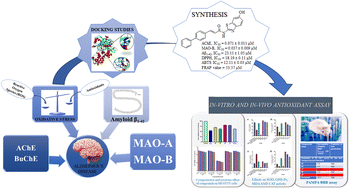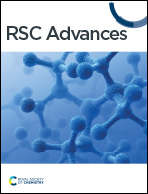Exploitation of the multitarget role of new ferulic and gallic acid derivatives in oxidative stress-related Alzheimer's disease therapies: design, synthesis and bioevaluation†
Abstract
Monoamine oxidases (MAOs) inhibitors could decrease reactive oxygen species (ROS) generation, enhance mono-aminergic neural transmission, and have major therapeutic benefits for the treatment of Alzheimer's disease (AD). Following the conjunction of ferulic acid (FA)/gallic acid (GA) with sulfonamide, alanine and 2-aminobenzothiazole, we planned to assess the radical scavenging and antioxidant properties of synthesized analogs by using 2,2-diphenyl-1-picrylhydrazyl (DPPH), 2,2′-azino-bis(3-ethylbenzothiazoline-6-sulfonic acid) (ABTS) and ferric ion reducing antioxidant power (FRAP) assays. GA analog 28 was identified as the most potent antioxidant compound with IC50 values of 1.77 μM and 2.06 μM in DPPH and ABTS assays respectively. In the in vitro enzyme inhibition assays, synthesized derivative 23 emerged as a potent multitarget inhibitor of hMAO-B, eeAChE. COX-2 and 5-LOX with IC50 values of 0.037 μM, 0.071 μM, 14.3 μM and 0.59 μM, respectively. Moreover, selected compounds 23, 25, 26 and 28 displayed good to moderate inhibition of self-mediated amyloid β1–42 peptide aggregation. More importantly, compounds 23, 25, 28 and 29 showed no neurotoxicity on SH-SY5Y cells and also showed excellent neuroprotective effects against H2O2-induced SH-SY5Y cells. In the in vivo experiment, antioxidant enzymes superoxide dismutase (SOD), catalase and glutathione peroxidase (GSH-Px) were studied in the brain of male BALB/c mice at the dose of 5 mg kg−1. All the tested compounds, except 29, have shown good to in vivo antioxidant potential. Docking studies on 3D crystallographic structures of AChE and MAO-B showed significant interactions with catalytic amino acid residues. In conclusion, the current study showed that FA/GA derivatives could be further exploited for their multitarget role in oxidative stress-related AD therapies.



 Please wait while we load your content...
Please wait while we load your content...